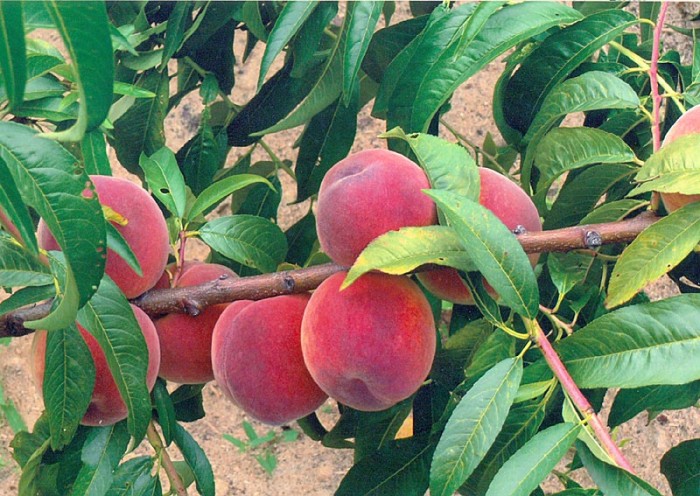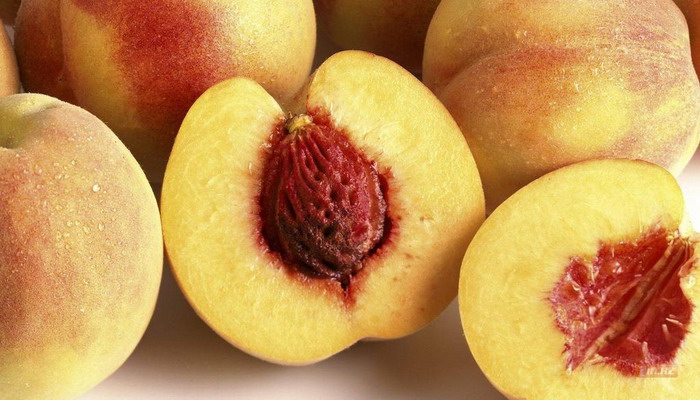Peach variety Ambassador of Peace - description
Different varieties of peaches have different traits that set them apart from each other. According to the ripening period, all varieties are divided into "early", "medium" and "late". There is also a classification for use: "dining", "canned" and "dried fruit". It is the peach, the ambassador of peace, that has all the necessary qualities to simplify the care of the crop and protect it without losing the level of yield.

Content
Description of the variety
The crowns of trees of this species are quite lush, spreading and rounded. The flowers themselves grow in the form of graceful bells, and the fruits, when fully ripe, reach an average of 160 g and are characterized by their rounded shape. The first peach will appear at the beginning of August. They are colored carmine (more than two-thirds of the surface of the fruit) and yellow. The very same peach pulp is a yellow ambassador of the world, dense, juicy, sweet and soft with a pleasant fibrous structure. The fruit stone is larger than average and is difficult to separate.

Dignity
The Ambassador of Peace variety is highly resistant to low temperatures, which allows it to be grown in difficult climatic conditions without deteriorating the quality of the fruit. Color buds are especially stable in winter. Like all other varieties, this one is characterized by a high yield. Harvested, as a rule, in mid-August. When the Ambassador of Peace variety reaches the age of 6 years or more, its yield ranges from 80 to 10 centners per hectare.

Care features
This variety requires regular annual pruning, which normalizes the yield to avoid overloading. Even with the onset of epiphytotic years, powdery mildew is not capable of causing significant harm. Despite the fact that this variety is drought-resistant, it still needs periodic uniform irrigation. During periods of extreme drought, it is recommended to water the crop approximately 2-3 times. The first watering should take place with the onset of June. The second - with the onset of July - in the first half of it. The third - with the onset of August. Since the soil must be impregnated with water to a depth of 70 cm (it is at this depth that the bulk of the roots is located), then up to 2 buckets should be spent for each square meter during each watering.
Depending on the type of soil on which the sowing of this variety of the ambassador of the world was carried out, the type of fertilizers themselves also depends. For example, podzolized soil needs periodic organic, phosphorus, nitrogen and potassium fertilizers, and sod-podzolic soil needs regular use of mineral and organic fertilizers. The regularity of using fertilizers directly depends on the frequency of watering. The more often the watering is, the more fertilizers the crop requires, since water flushes nutrients from the soil. Of course, proper farming techniques are needed to properly care for the peach.
Before planting, mix the soil with manure (10 kg), superphosphate (50 g), wood ash (300 g) and potassium chloride (50 g). Every year, the crop is fertilized in the area of the trunk circle. A couple of years after planting, the peach needs a spring digging in the aforementioned area, followed by the addition of urea (55 g) and ammonium nitrate (74 g). With the arrival of autumn, digging is carried out again and potash (from 50 g to 70 g) and phosphorus (from 45 g to 50 g) fertilizers are added. Organic fertilizers are also used every 2-3 years during spring digging. After each cycle of the same period, the amount of fertilizer is increased by 20 g.
When the peach crosses the age threshold of three years, it is pruned exclusively in the spring, starting in March and ending in mid-April. Dying branches also need to be cut periodically. It is highly discouraged to prune trees in the fall, as this will negatively affect the resistance to low temperatures in winter. Do not forget about the cutting of the crown, which is carried out annually in order to make it easier for the sun to get inside so that the peach can grow fully.
